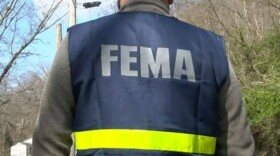It began last June, when a worker at a limestone quarry in southeast England felt "unusual bumps" as he was digging up clay.
Now a team of over 100 researchers from the Universities of Birmingham and Oxford have determined that the mysterious bumps found at Dewars Farm Quarry in Oxfordshire were in fact dinosaur tracks dating back to the Middle Jurassic period, around 166 million years ago.
Paleontologists say the some 200 footprints discovered along five different trails offer new insights into certain dinosaurs' size and speed.

"All of the dinosaurs, based on our estimates of speed, were probably walking rather than running," said Kirsty Edgar, a professor of micropalaeontology at the University of Birmingham who worked on the discovery site.
Edgar told NPR that the environment for the dinosaurs at the time "was probably lagoonal, probably looked something like the Florida Keys today."
Researchers uncovered five trackways buried in the mud, the longest one measuring nearly 500 feet in length. Four of the trackways were made by long-necked herbivorous sauropods, suspected to be the giant 60-foot, two-ton Cetiosaurus, while a fifth set was made by a carnivorous Megalosaurus.
The Megalosaurus, a ferocious 30-foot-long predator, is famous for its distinctive large three-toed feet with claws. It is also the first dinosaur to ever be scientifically named, in 1824, by Oxford geologist William Buckland. Buckland's unusual fossil discovery kicked off what is now more than 200 years of dinosaur research.

One area of the excavation site showed the Megalosaurus and sauropod tracks crossing over, raising additional questions about how and if the two species interacted.
"Scientists have known about and been studying Megalosaurus for longer than any other dinosaur on Earth, and yet these recent discoveries prove there is still new evidence of these animals out there, waiting to be found," said Emma Nicholls, a vertebrate palaeontologist at Oxford Museum of Natural History.
Each Megalosaurus track was around 25 inches long, with a stride of about 8.8 feet. Based on those measurements, scientists estimate the dinosaur walked at a pace of around 3 miles per hour, similar to an average adult human walking speed. They believe the sauropods walked at a similar pace.
Tracks were first discovered in the area in 1997, when limestone quarry workers stumbled upon more than 40 sets of dinosaur footprints, with some trackways reaching up to nearly 600 feet in length. The British government named the Oxfordshire site as one of the most important dinosaur track sites in the world, with the discovery providing major pieces of evidence about the species of dinosaurs that roamed the U.K. during the Middle Jurassic Period.
During the latest excavation, researchers captured more than 20,000 images of the 200 footprints.
Copyright 2025 NPR








